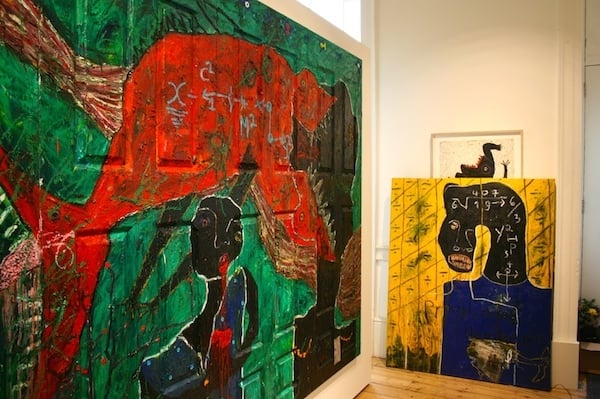
Photo: Lorena Muñoz-Alonso
In the whirlpool created by the “Frieze Week effect”, numerous satellite art fairs have sprung up across London in the last few years. But with the recent move of the Moving Image art fair to Istanbul, there are two that clearly stand out in the jamboree as the most significant alternatives to the carpeted floors of the Frieze tents in Regent’s Park.
Just a 10 minutes’ walk from Frieze, Sunday Art Fair is showcasing 23 young, cutting-edge galleries in a rather unassuming, low-key fashion. Housed in a subterranean exhibition space that is part of the University of Westminster, Sunday jilts the traditional booth concept and embraces an open plan layout, which is as messy as it is convivial. Now in its fifth edition, Sunday has established itself as an unmissable art event for those that are looking for something a little more challenging and obscure than the glitz and bling being distilled nearby at Frieze.
Rob Tufnell, co-director of Sunday, explained the fair’s idiosyncrasies to artnet News: “Sunday is an insider’s fair, which functions by word of mouth, rather than with a huge PR and marketing machinery. But we do share a big collector base with Frieze, as well as a fluid gallery crossover. Many galleries that have participated in Sunday are now showing in Frieze—including London’s Limoncello, Arcade, or MOT International. And Gaudel de Stampa from Paris, which participated in Frieze last year, is showing with us this time.”
Sunday Art Fair is a slow burner. Because many of the displayed artworks aren’t flashy or eye-catching, they demand attention from the visitor, only revealing their qualities after careful observation. In this year’s edition, Vancouver’s The Apartment stands out, with a great presentation of early photographic works by Janice Guy (perhaps more famous in her current incarnation as cofounder of the gallery Murray Guy) and the American sculptor B. Wurtz. Nearby, Rob Tufnell delights with a display of the playful ceramic sculptures of the young British artist Aaron Angell. The Berlin gallery Sandy Brown offers a fantastic two-artist presentation with works by the French artists Aude Pariset and Jean-Michel Wicker.
The Apartment at Sunday Art Fair 2014, with works by Janice Guy and B. Wurtz.
Photo: Courtesy of The Apartment.
“Sunday embraces the periphery,” Tufnell told artnet News. “We are showing galleries from Milwaukee, Vancouver, or Munich, which are not traditional art centers. Because it is a smaller and more affordable fair to participate in, galleries also feel free to take more risks. If you invest in showing in Frieze you want to make sure you are going to sell. Sunday offers more of a margin to experiment,” he continued.
Meanwhile, in the grand neoclassical building of Somerset House, the second edition of 1:54, the Contemporary African Art Fair is also unfolding. After the roaring success of its debut last year, the fair has expanded from 15 to 27 international galleries, presenting the work of over 100 African artists.
On the day after the private view, all of the gallerists artnet News contacted reported strong sales and visits from key collectors, including Charles Saatchi and Jean Pigozzi, as well as museums like the Tate.
Somerset House, the setting of 1:54. Courtesy of Getty Images.
“I am delighted with the success of 1:54,” Touria El Glaoui, the fair’s founder, told artnet News. “I started the project because I recognized the need for an international platform to give global visibility to a great generation of artists.”
With 1:54 being the only art fair outside Africa specialized in African art, it’s easy to see why her formula has proven so successful in such a short time. “The idea of collecting ‘African art’ is actually a rather Western concept. There is a healthy art market in Africa, but collectors usually buy the works of artists from their specific countries,” El Glaoui explained.
At 1:54, a great number of galleries are opting for solo or two-person presentations. New York’s Taymour Grahne Gallery is showcasing the fascinating work of the Paris-based Algerian artist Fayçal Baghriche. Baghriche’s “Family Friendly” series are delicate interventions made to the images of imported magazines, marked out by censors before circulation in the UAE. His torso sculptures, made of plastic with wax inserts, are a poignant play with materiality and decay.
London’s Knight Webb Gallery is staging a solo presentation of paintings by the Cameroon-born, London-based artist Adjani Okpu-Egbe. Expressive and bursting with color, Okpu-Egbe’s paintings manage to be uplifting and socially engaged at the same time, reflecting past experiences and encounters with “underdogs”, like the one-eyed survivor of the Syrian conflict whom he shared a bus journey with.
“I think people relate to African art on an emotional level,” Touria El Glaoui told artnet News. “It is direct and easy to understand, perhaps less intimidating than Western conceptual art,” she continued. Reflecting on the growing interest of Western countries in contemporary African art, however, El Glaoui remained cautious: “I am wary of the ‘boom’ of African art. I would prefer a stable, slowly growing type of interest. That’s what it deserves.”